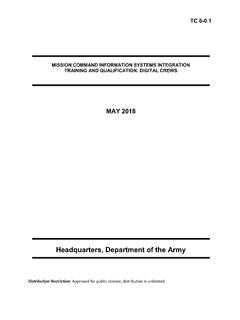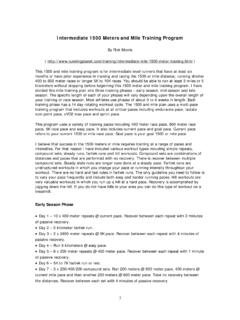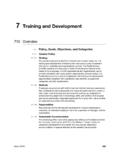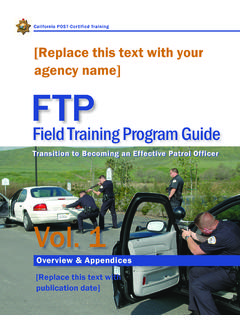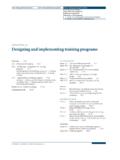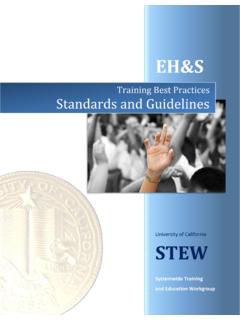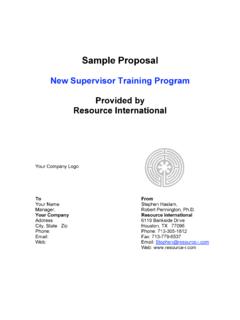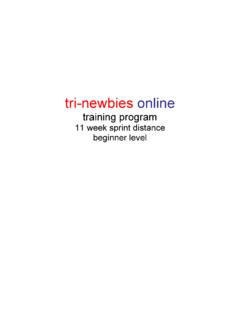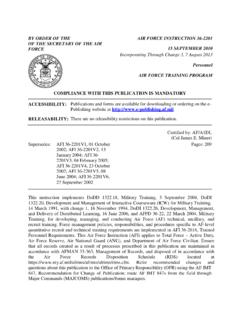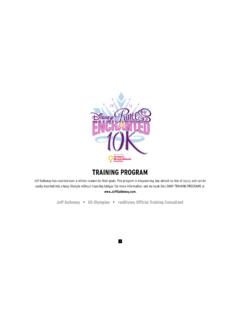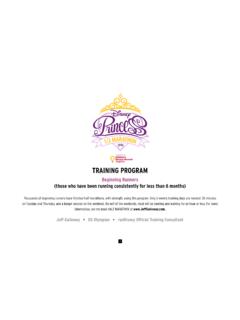Transcription of Training Combat Training Center Program - armypubs.army.mil
1 UNCLASSIFIED army Regulation 350 50 Training Combat Training Center Program Headquarters Department of the army Washington, DC 2 May 2018 SUMMARY of CHANGE AR 350 50 Combat Training Center Program This major revision, dated 2 May 2018 o Updates vision statement (para 1 5a). o Clarifies mission of Joint Multinational Readiness Center to enable Non- Combat Training Center event support (para 1 5e(2)). o Adds Combat Training Center Program support to the army s Emergency Deployment Readiness Exercise Program (para 1 5h). o Adds fidelity and specificity to the observer, coach, trainer requirements for Combat Training Center rotations and warfighter exercises (para 1 6b(1)). o Adds responsibilities for Assistant Secretary of the army (Installations, Energy and Environment) (para 2 2). o Adds responsibilities for Commanding General, army Central (para 2 17). o Adds responsibilities for Commanding General, army Pacific (para 2 18).
2 O Adds responsibilities for Commanding General, army Africa (para 2 19). o Defines range threshold and objective capabilities for the Maneuver Combat Training Center s live fire exercises (para 3 2b). o Defines pre-rotational proficiency level requirements and post rotational proficiency expectations/desired outcomes (para 3 2c). o Clarifies Training audience and context for Mission Command Training Program Warfighters (para 3 2e(1)). o Refines the list of participants and adds construct and purpose to the Chief of Staff, army Combat Training Center Huddle (para 3 3b(1)). o Aligns Combat Training Center governance process with current Training General Officer Steering Committee structure and process (para 3 3e). o Aligns and refines Combat Training Center Working Group/Quarterly Review voting and advisory membership in accordance with current command hierarchies (table 3 1).
3 O Updates provisions for multinational unit participation in Combat Training Center rotations (para B 1). o Replaces outdated army Force Generation terminology with the enduring phrase army unit readiness, force generation processes (throughout). o Deletes all references to the Exportable Training Capability, which is no longer a Combat Training Center Program requirement (throughout). o Changed Joint Multinational Training Command to 7th army Training Command (throughout). *This regulation supersedes AR 350-50, dated 3 April 2013. AR 350 50 2 May 2018 UNCLASSIFIED i Headquarters Department of the army Washington, DC * army Regulation 350 50 2 May 2018 Effective 2 June 2018 Training Combat Training Center Program History. This is a major revision. Summary. This regulation establishes policy for Armywide management of the Combat Training Center Program . Applicability. This regulation applies to the Regular army , the army National Guard/ army National Guard of the United States, and the army Reserve, unless otherwise stated.
4 Proponent and exception authority. The proponent of this regulation is the Deputy Chief of Staff, G 3/5/7. The pro-ponent has the authority to approve excep-tions or waivers to this regulation that are consistent with controlling law and regula-tions. The proponent may delegate this ap-proval authority, in writing, to a division chief within the proponent agency or its di-rect reporting unit or field operating agency, in the grade of colonel or civilian equivalent. Activities may request a waiver to this regulation by providing justification that includes a full analysis of the expected benefits and must include formal review by the activity s senior legal officer. All waiver requests will be endorsed by the commander or senior leader of the request-ing activity and forwarded through their higher headquarters to the policy propo-nent.
5 Refer to AR 25 30 for specific guid-ance. army internal control process. This regulation contains internal control provi-sions in accordance with AR 11 2, and identifies key internal controls that must be evaluated (see appendix C). Supplementation. Supplementation of this regulation and establishment of agency, command, and installation forms are pro-hibited without prior approval from the Deputy Chief of Staff, G 3/5/7 (DAMO TR), 400 army Pentagon, Washington DC 20310 0400. Suggested improvements. Users are invited to send comments and suggested improvements on DA Form 2028 (Recom-mended Changes to Publications and Blank Forms) directly to the Headquarters, De-partment of the army , Deputy Chief of Staff, G 3/5/7 (DAMO TR), 400 army Pentagon, Washington, DC 20310 0400. Committee management. AR 15 39 requires the proponent to justify establish-ing/continuing committee(s), coordinate draft publications, and coordinate changes in committee status with the Office of the Administrative Assistant to the Secretary of the army , Department of the army Com-mittee Management Office (AARP ZA), 9301 Chapek Road, Building 1458, Fort Belvoir, VA 22060 5527.
6 Further, if it is determined that an established group identified within this regulation later takes on the characteristics of a committee, as found in AR 15 39, then the proponent will follow all AR 15 39 requirements for es-tablishing and continuing the group as a committee. Distribution. This regulation is available in electronic media only and is intended for the Regular army , the army National Guard/ army National Guard of the United States, and the army Reserve. Contents (Listed by paragraph and page number) Chapter 1 Introduction, page 1 Purpose 1 1, page 1 References 1 2, page 1 Explanation of abbreviations and terms 1 3, page 1 Responsibilities 1 4, page 1 Proposed vision, intent, and objectives 1 5, page 1 Concepts 1 6, page 4 Chapter 2 Responsibilities, page 7 Assistant Secretary of the army (Acquisition, Logistics and Technology) 2 1, page 7 Assistant Secretary of the army (Installations, Energy and Environment)
7 2 2, page 7 Chief Information Officer/G 6 2 3, page 7 Contents Continued ii AR 350 50 2 May 2018 Chief, Public Affairs 2 4, page 7 Deputy Chief of Staff, G 1 2 5, page 8 Deputy Chief of Staff, G 2 2 6, page 8 Deputy Chief of Staff, G 3/5/7 2 7, page 8 Deputy Chief of Staff, G 4 2 8, page 9 Deputy Chief of Staff, G 8 2 9, page 9 Assistant Chief of Staff for Installation Management 2 10, page 9 Director, army National Guard 2 11, page 9 Chief, army Reserve 2 12, page 10 Chief of Engineers 2 13, page 10 Commanding General, army Forces Command 2 14, page 10 Commanding General, army Training and Doctrine Command 2 15, page 11 Commanding General, army Europe 2 16, page 13 Commanding General, army Central 2 17, page 14 Commanding General, army Pacific 2 18, page 14 Commanding General, army Africa 2 19, page 14 Commanding General, army Special Operations Command 2 20, page 15 Commanding General, army Space and Missile Defense Command/ army Forces Strategic Command 2 21, page 15 Commanding General, army Medical Command 2 22, page 15 Commanding General, army Corps of Engineers 2 23, page 15 Commanding General, army Test and Evaluation Command 2 24, page 15 Commanding General, army Cyber Command 2 25, page 16 Commander, army Combat Readiness Center 2 26, page 16 Commanding General, Installation Management Command 2 27, page 16 Commanders, Combat Training Centers (Mission Command Training Program , 7th army Training Command, Joint Multinational Readiness Center , Joint Readiness Training Center , and National Training Center )
8 2 28, page 16 Program Executive Office for army Simulation, Training , and Instrumentation 2 29, page 17 Program executive officers and/or project managers 2 30, page 17 Chapter 3 Combat Training Center Program Planning and Management, page 18 Policies 3 1, page 18 Training strategy 3 2, page 18 Combat Training Center Program Organization and Management 3 3, page 20 Combat Training Center Master Plan 3 4, page 22 Scheduling 3 5, page 22 Combat Training Center capabilities and/or rotation requirements 3 6, page 22 Appendixes A. References, page 24 B. Use of Combat Training Center by Other Nations, page 27 C. Internal Control Evaluation, page 34 Table List Table 3 1: Combat Training Center Program Working Group/Quarterly Review Membership, page 21 Table B 1: Request for visit to continental United States Combat Training Center from foreign nation, page 28 Table B 2: Request from foreign nation for Training at a continental United States Combat Training Center rotation (in-cludes support under provisions of reciprocal unit exchange, foreign military sales, or funding including foreign military financing), page 30 Glossary AR 350 50 2 May 2018 1 Chapter 1 Introduction 1 1.
9 Purpose This regulation describes the objectives, organizations, and concepts of operations for the Department of the army (DA) Combat Training Center (CTC) Program . It also designates Headquarters, Department of the army (HQDA), Deputy Chief of Staff (DCS), G 3/5/7 as the CTC Program Director with Program execution authority on behalf of the Chief of Staff, army (CSA). Finally, it prescribes CTC Program responsibilities, policies, and planning and programming guidance for the shared command and control (C2), management and administration, and advisory roles of the army Training and Doctrine Command (TRADOC), army Forces Command (FORSCOM), and army Europe (USAREUR). 1 2. References See appendix A. 1 3. Explanation of abbreviations and terms See glossary. 1 4. Responsibilities Responsibilities are listed in chapter 2. 1 5. Proposed vision, intent, and objectives a. Vision. The army s CTC Program remains the cornerstone of an integrated strategy that builds trained and profi-cient, Combat -ready units and leaders to conduct operations as part of the joint force-ready to win in a complex world.
10 CTCs provide a crucible experience for units and leaders Training in a complex and highly realistic decisive action Training environment (DATE) designed to replicate Combat by stressing every warfighting function with operations against tough, freethinking, realistic, hybrid threats under the most difficult conditions possible. The CTCs will accelerate a return to standards-based Training and the pace of the army s transition to unified land operations (ULO) by challenging units and leaders to adapt to battlefield conditions, and by enhancing lethality and our ability to operate with our unified action partners (UAPs) and special operations forces (SOFs) across the range of military operations. The end state will be units and leaders prepared to deploy worldwide, fight with confidence, and win against any adversary, anytime, under any con-ditions. b. Objectives. (1) Focus on a mission-essential task list (METL) with Training for Combat operations as part of the joint team.


